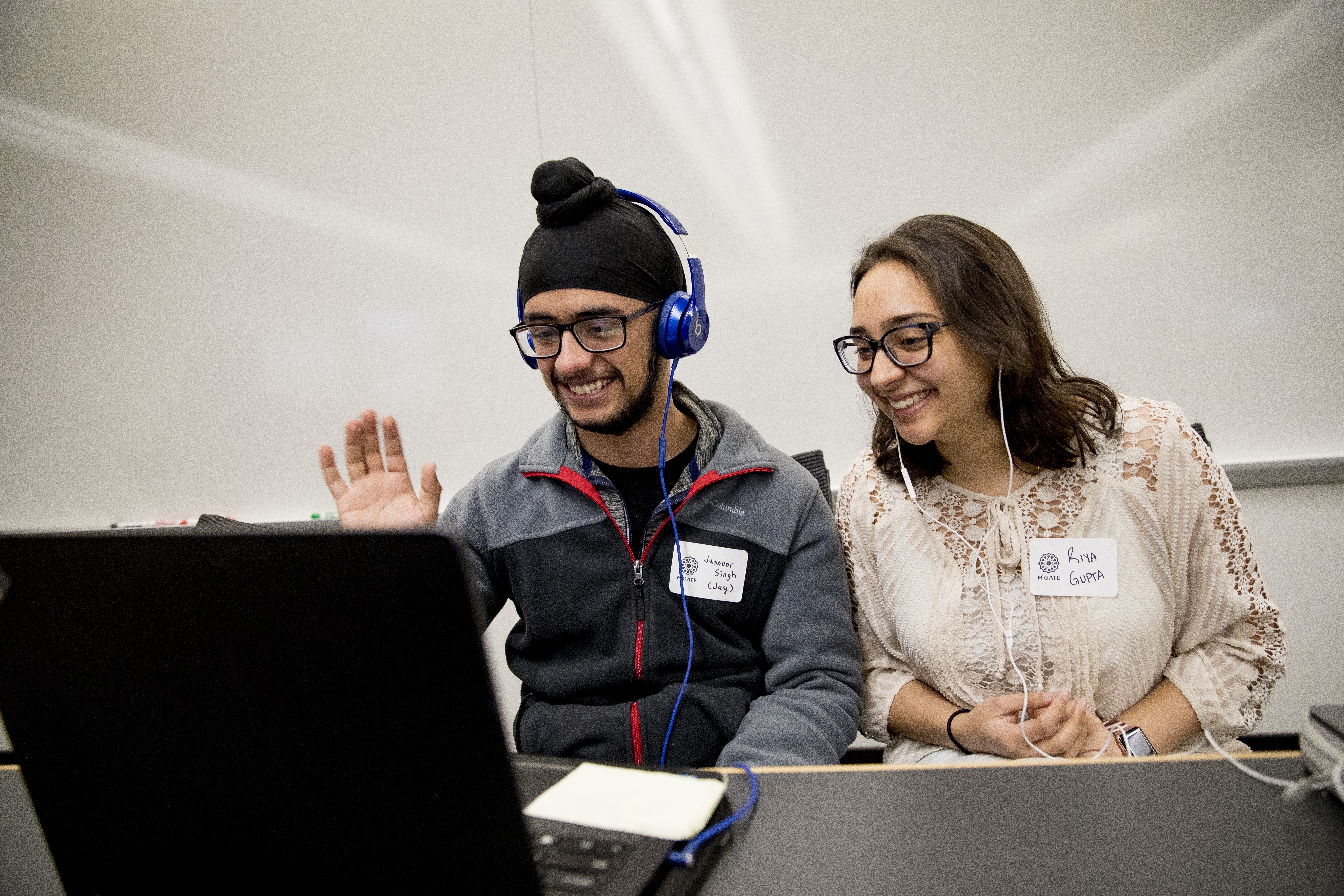
Cross-cultural relationships in business can be challenging, but students adept at navigating them are far more likely to excel in business— not to mention a host of other global professions and fields.
A unique course, offered at the Ross School of Business and facilitated by WDI, will equip students with the skills they need to work on cross-cultural, geographically dispersed teams so common in today’s business world. Open to all majors, the course uses technology to connect U-M students with their peers in Egypt, Lebanon and Libya.
Business & Culture: A Virtual Practicum (BA310), a new 14-week, three-credit course, will serve up a mix of traditional classroom sessions and hands-on, experiential activities. The innovative course will be offered in the winter 2020 semester and most students may register through Wolverine Access now.
The course will increase students’ awareness of the scope and nature of cross-cultural business and allow them to apply their new knowledge through work in international teams. It will be led by Ross Clinical Assistant Professor and WDI Faculty Affiliate John Branch, along with professors from American University in Cairo and American University in Beirut and the founder of the Benghazi Youth for Technology and Entrepreneurship in Libya.
“Success in business, and increasingly also in life in general, requires cultural competence—the ability to navigate culturally awkward situations, respect for alternative worldviews and the skills to lead people who are different,” Branch said. “Arguably, when it comes to developing cultural competence, nothing can replace a cross-cultural experience living, studying, or working abroad.”
But Branch said today’s interconnected world allows a simulation of a cross-cultural experience.
“Using the internet and other technologies, it enables students from four countries to work and study together,” he said. “They will ‘attend’ course sessions together, studying cases which reveal unique cultural approaches to business.”
Students will maintain a journal filled with their cultural reflections and also participate in an online discussion forum with their international peers where ideas, opinions and questions are shared. For the final project, students will form international teams and research and plan the internationalization of a fictitious company.
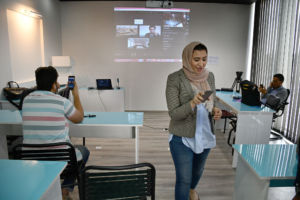
The course is expected to run four times beginning winter 2020. It builds off WDI’s successful project from 2017 and 2018, the MENA-Michigan Initiative for Global Action Through Entrepreneurship (M²GATE) program. That project brought together more than 400 students from five Michigan university campuses, including U-M, and their peers in Egypt, Libya, Morocco and Tunisia. M²GATE and the Business & Culture course were both supported by the Stevens Initiative, which is sponsored by the U.S. Department of State, with funding provided by the U.S. Government, and is administered by the Aspen Institute. The Stevens Initiative is also supported by the Bezos Family Foundation and the governments of Morocco and the United Arab Emirates.
In addition, WDI’s Performance Measurement and Improvement (PMI) will evaluate the impact the program has on students in the U.S., Libya, Lebanon and Egypt in areas such as empathy and cross-cultural skills, and use the findings to look for ways to improve subsequent BA310 classes. The data from the PMI team’s work also will be used to optimize future virtual exchange courses.
“Virtual exchange is an ideal way to prepare students for the global workforce they’ll soon be part of,” said Amy Gillett, academic advisor of the new program and vice president of WDI’s Education sector. “It’s also a fun and exciting way to learn and a great way to build an international network.”
Yaquta Fatehi, a program manager with WDI’s Performance Measurement & Improvement team, presented and moderated a panel at the “Sustainability and Development 2019” conference in October organized by the School of Environment and Sustainability (SEAS) at the University of Michigan. WDI’s session, “Tracking and Improving Progress to Sustainable Development with the Private Sector,” fell under one of the conference themes of “Mobilizing the Private Sector.”
This session also included panelists from World Vision, the University of Michigan and Erasmus University Rotterdam. The presentation slides can be downloaded below.
The session abstract read: Poverty data can provide unique insights into a company’s clients. Collecting such data can uncover truths of who is being reached and what their needs are, which in turn provides opportunities for the company to better meet those needs along the value chain as well as advance their overall sustainable development. This session will share the experience from designing, collecting and analyzing such data with one enterprise based in Mexico City, Mexico. The presenter will share the method used in designing the M&E plan, the key performance indicators, and the findings from data collection that were used to develop recommendations to strengthen the enterprise’s sustainability and design a performance monitoring system. The presenter will also discuss the benefits of shifting the dialogue of ‘M&E for accountability and reporting’ to ‘M&E for that but also continuous learning and adaptive management’. The presenter will also share lessons learned from working with private sector partners on projects across the globe including India, Kenya, etc., and share certain tools to strengthen this type of relationship. The session will also share key performance indicators that can be used to measure the Sustainable Development Goals.
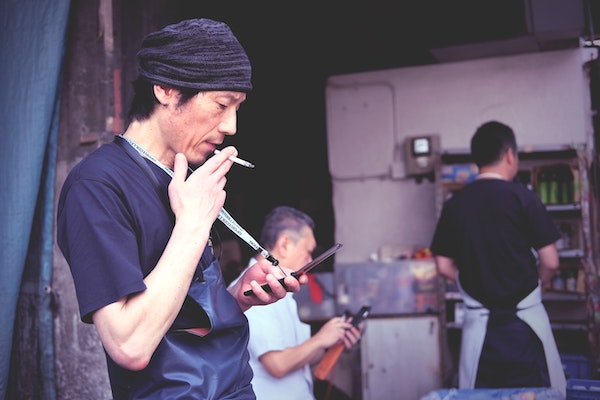
Photo by Erica Leong on Unsplash
Government health ministries in low- and middle-income countries (LMICs) have historically struggled to adequately fund healthcare services for their citizens. But as these countries transition away from donor funding over the next two decades, many will need to find new domestic revenue streams to finance these services. A new WDI white paper explores the impact of raising additional government revenue through increased tax rates on “bads,” such as tobacco, alcohol and sugary drinks.
The paper, “Revenue Estimates from Taxing ‘Bads’ in 16 Low- and Middle-Income Countries,” estimates the additional revenue generated in 2016 had higher excise tax rates been imposed on tobacco, alcohol and sugary drinks and then compares this revenue to select national economic indicators. The analysis included 16 low- and middle-income countries: Côte d’Ivoire, Democratic Republic of the Congo, Ethiopia, Haiti, India, Lao People’s Democratic Republic, Moldova, Myanmar, Niger, Papua New Guinea, Rwanda, Senegal, Sierra Leone, Tajikistan, Tanzania and Togo.

Ben Davis
“The key finding is that increased excise tax rates that result in only a modest increase in retail price can still generate an important amount of additional revenue relative to current health expenditure,” said Ben Davis, a research manager with WDI’s Healthcare sector. Davis wrote the paper with Pascale Leroueil, vice president of WDI’s Healthcare sector, and William Savedoff, senior fellow at the Center for Global Development.
The simulations showed that in 14 of the 16 countries, a tax increasing retail price by 17% could generate additional revenue that is more than 50% of the amount these governments currently spend from their own budgets on healthcare. For 7 of the 16 countries, additional revenue is more than 100% of that amount.
Davis emphasized that the study has limitations. For example, estimates do not account for income and cross-substitution effects (or when consumers switch to cheaper alternatives when a product’s price rises), and they are not adjusted based on historical experience in raising tax revenues.
While the results of the current study are broadly aligned with those recently produced by the Bloomberg Philanthropies’ Task Force on Fiscal Policy for Health, there is a slight difference in methodology. The method used by Davis and his fellow authors allowed them to incorporate several different data sources and calculation methods in the final revenue estimates. Input data were obtained from public databases, journal articles, and LMIC government websites and then used in either a “bottom up” or a “top down” calculation. The “Bottom up” calculation begins with data showing how often individuals consume tobacco, alcohol and sugary drinks while the “top down” calculation begins with the amount of money actually collected by LMIC governments that taxed these products.
Davis said these estimates could act as a starting point for a discussion between global donor organizations and country governments. “A government stakeholder might say, ‘These results are interesting. An increased excise tax on these products might be worth considering. Let’s do a deeper analysis to make sure these numbers reflect reality when we take into account all of the factors that couldn’t be captured in the initial study.’”
“This paper is a small part of a larger conversation about domestic revenue mobilization and healthcare financing in low- and middle-income countries,” Davis said. “It is a building block.”
With funding support from the Aspen Network of Development Entrepreneurs (ANDE) at the Aspen Institute and Canada’s International Development Research Centre (IDRC), WDI is working with Gente del Futuro (GDF)– a for-profit partnership between three private players within the coffee sector. Together, GDF and WDI are working to collect empowerment data from women working with GDF in Colombia. GDF believes that making coffee more profitable and empowering young people, particularly women, through practical and technical training can promote a more inclusive approach to develop better functioning coffee chains.
To help accomplish this objective, WDI is supporting GDF to pretest and pilot a short quantitative survey that examines how empowerment differs based on women’s role in the coffee value chain. The data will be used to use to inform GDFs operations, in particular how they can better engage and empower women. The survey will be administered to a sub-sample of the 300-500 women that GDF has worked with over the years in Colombia and will assess decision-making and empowerment at home and work.

Note: The following post was originally published on NextBillion.net, which is managed by WDI.
In emerging economies, businesses and other organizations engage in work that can be really messy and staggeringly complex. They know it’s important to measure the social impact of their work, but they often struggle to find the right approach, spending money on measurement strategies that are designed for static environments. Like dieters looking for a quick weight loss solution, they try one approach or another, then grow frustrated when these strategies fail, delivering results that they won’t use – or worse, can’t use. After experimenting with evaluations that end up wasting their time and money, they might even decide that measuring their impact isn’t worth the effort.
These organizations may not realize that there’s a better approach, more geared toward the unique challenges they face. Called “developmental evaluation” – often just referred to as “DE” – it was created to support innovative programs that operate in complex environments, and are thus expected to adapt over time. Developed in response to the problem of under-utilized data and hit-or-miss evaluations, DE is different from traditional evaluation methods, such as Randomized Controlled Trials or pre/post-intervention tests. It’s methodologically agnostic and utilization-focused, employing data collection, analysis and feedback that are quick, ongoing and iterative. It can draw on many different evaluation methods to collect data, with the purpose of aiding decision-making – even when a program is still developing. It’s more similar to R&D in the product development process of private sector companies, because it provides program staff with data-based feedback in real time (or close to real time), thus facilitating a continuous development loop.
DE achieves this by having one (or more) Developmental Evaluators integrated into the program implementation team, on a full- or part-time basis. These Developmental Evaluators collect and analyze data, which helps the organization make modifications in program design and achieve targeted outcomes. They participate in team meetings, and document decisions, processes and dynamics, with the goal of helping staff make decisions based on the latest and most relevant data to their particular context.
To extend the weight loss analogy: From the perspective of evaluation participants, DE resembles not a fad diet, but a new evaluation lifestyle. It views measurement less as a temporary, occasional effort driven from outside, but rather as an integral part of an organization’s ongoing work. Let’s take a closer look at the approach, to explore how to make a DE successful – and to determine whether it would be a good fit for your organization.
As any doctor will tell you, a healthy lifestyle generally includes frequent exercise. So let’s continue this analogy by comparing DE to a balanced workout: As it happens, DE includes many of the same essentials that a good, well-rounded workout would.
DEs come equipped with their own personal trainer: the Developmental Evaluator. Like any good fitness coach, the Developmental Evaluator is there to personalize the evaluation methods and activities to your specific needs. Hiring a Developmental Evaluator can sometimes be the hardest part of a DE, because you want to choose someone who is well-qualified to lead you through the DE process, and who can help your team establish data-driven evaluation methods that you can actually use to inform strong program strategy. Top credentials to consider in a candidate include: experience in qualitative and quantitative methods, facilitation skills or a background in co-designed processes, and a proven ability to work in uncertain environments.
Just as it’s important to warm up before starting a strenuous workout, it’s essential to get warmed up before you jump into a DE. If you don’t, you might hurt the evaluation’s chances for success. To prepare for this process, DEs often include one or more activities, such as a kick-off workshop, to help teams understand what DE is and how it can be useful to them – including how to best leverage the role of the Developmental Evaluator.
As you kick off a DE, identify and target the areas where you think measurement will add immediate (and long-term) value. If you’re warming up for a 5K run, you would target your legs and not just limit yourself to upper-body stretches. Similarly, if you’re starting a DE that is focused on stakeholder engagement, you might start with a stakeholder mapping exercise as a quick win for your teams.
Like any effective workout regimen, a DE should include a balanced mix of activities. Some activities will be hard, heavy lifts that only need to be completed once or twice at the beginning or end of the DE (think: strength training). For instance, if you want to build strength in your DE, you need to work hard to fully integrate the Developmental Evaluator into your team. This is one of the first and most important weights you can lift in DE, and it may require a few heavy pushes. You’ll need to introduce the Developmental Evaluator to all DE stakeholders, set up standing meetings, get into the habit of cc’ing them on emails, and make space for them at your office. But once they are integrated, you’ll have built the strongest muscle you need to power through the DE.
Other activities and processes take more endurance and will need to be performed throughout the life of the DE to maintain their benefits (think: cardio). In these cases, perseverance and stamina will pay off, especially when it comes to building buy-in and stakeholder support for the DE. Because a team’s willingness to engage in a DE may change with each new evaluation question, or with the sharing of negative results, promoting buy-in for the DE takes both time and endurance – it is more a long distance run than a sprint. And even if you hit a nice stride early on, the level and pace of buy-in for the DE can change as you navigate new terrain, such as staff turnover, product launches or new leadership decisions. The Developmental Evaluator and DE stakeholders will need to foster a culture of open learning and adaptability throughout the life of the DE.
To properly end your DE workout, you’ll need to do some cool-down activities to ensure that you don’t harm your organization. Most importantly, when ending the DE, take the time to “de-integrate” the Developmental Evaluator from your team. This may include handing off the Evaluator’s responsibilities to permanent staff, ensuring that action plans are in place to carry DE recommendations forward, and preparing teams to continue their work with a focus on continuous learning – even without the added support of the Developmental Evaluator.
Last but not least, a healthy lifestyle requires good – and ongoing – nutrition habits. Likewise, if you want to get the most out of your DE, you have to continue with the healthy measurement habits it has established, even after the evaluation has ended. It’s important to pause and reflect regularly, to make sure your DE leads to data-driven decision-making and strategic thinking within your team in the long term. Schedule recurring meetings or workshops to help internalize the DE’s data and findings. This will ensure that your team has truly absorbed the learnings generated by the DE.
If you were to look at your organization’s current evaluation practices, would you say they fall more into the category of “fad diet” or “healthy lifestyle”? It’s an important question, and it’s essential to answer it through an honest reflection on your organization’s needs and capabilities.
After engaging in this self-assessment, you may decide that DE is not appropriate for your situation, organization or business – the approach is not for everyone. But it’s well worth considering, especially for programs operating in complex environments, or without an established theory of change. It can also be used alongside market-based approaches that embed the principles of social innovation and social enterprise into an organization.
DE could be just what you need to establish a healthy evaluation lifestyle: one that balances, in equal parts, data-driven evaluation methods and a strong program strategy.
Want to learn more about DE? Check out these resources – or connect with WDI’s Performance Measurement and Improvement teamto see if DE (or another area of continuous improvement) fits your needs:
Author’s note: Almost five years ago, the United States Agency for International Development launched the Developmental Evaluation Pilot Activity (DEPA-MERL) under the U.S. Global Development Lab’s Monitoring, Evaluation, Research, and Learning Innovations program to test how developmental evaluation (DE) could be used in situations where traditional approaches to program evaluation were not a fit. This blog was inspired by findings from the three DEs conducted by the DEPA-MERL consortium from 2016-2019.
Yaquta Kanchwala Fatehi of the William Davidson Institute and David Yamron of Search for Common Ground contributed to this report.
Rebecca Baylor is a research associate with the Performance Measurement and Improvement team at the William Davidson Institute.
Photo courtesy of renategranade0.
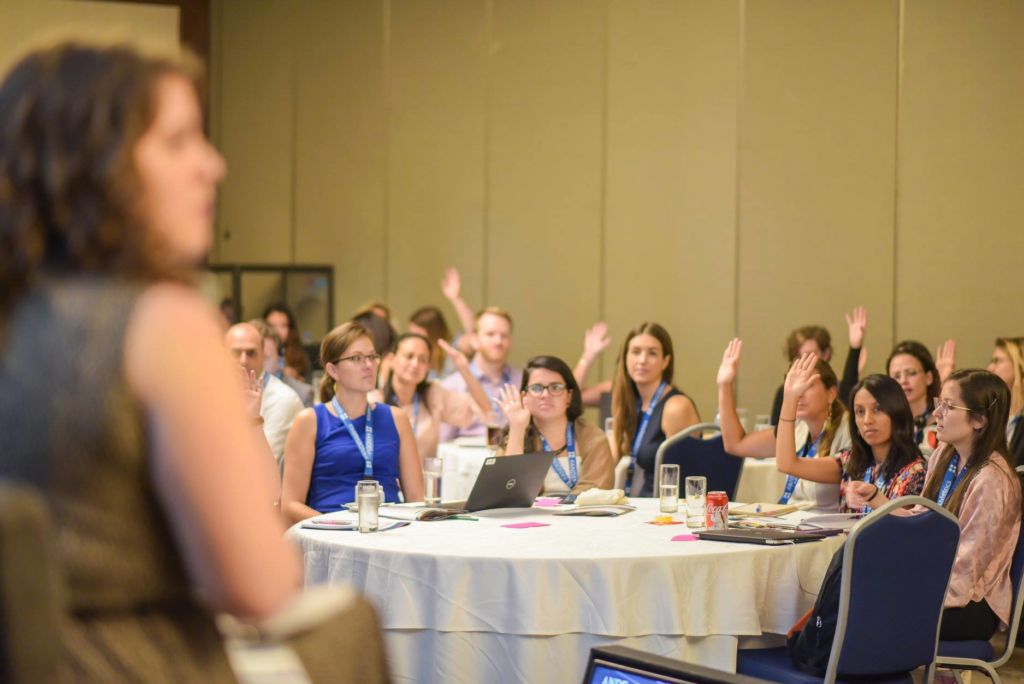
Rebecca Baylor, (foreground left), leads a discussion at the ANDE metrics conference. (Photo courtesy of ANDE.)
In my work as a research associate on WDI’s Performance Measurement and Improvement team, evaluation of impact is paramount. We work with leaders from businesses and nonprofits to measure their impacts and help them continuously improve on a variety of outcomes – from understanding their employees’ quality of life to the poverty probability of the clients they serve.

Rebecca Baylor
But more and more, our partners are interested in understanding their contributions to a greater gender-balanced world. They want to find the right gender-based measurement solutions within their particular context, and that requires a certain level of trust – and transparency. And, unfortunately, when it comes to data-driven evidence around women’s empowerment, sometimes there is a lot of talk and little action.
Luckily, organizations such as the Aspen Network of Development Entrepreneurs are examining what is being done to incorporate gender equality into the impact measurement space by hosting events such as the recent Metrics from the Ground Up conference. Held this year in Mérida, Mexico, the annual conference brings together research and evaluation experts with leading practitioners in the small and growing business (SGB) sector to share insights and address common challenges in impact measurement. This year’s theme was “Impact Measurement with a Gender Lens.”
At the conference, I moderated a discussion on using gender data to drive better decision-making that featured panelists from international businesses, accelerators and non-profits that are collecting and using this data to improve programs and products for SGBs.
From a coffee business in Kenya to the Cali, Colombia Chamber of Commerce, we discussed how gender data can provide unique insights into a company’s clients or a program’s beneficiaries. Panelists gave examples of how collecting such data can uncover who is being reached and what their needs are, which, in turn, provides opportunities for their company or program to better meet those needs.
The panel also discussed how collecting sufficient data about gender equality can be challenging, particularly in complex international settings.
A common thread in the discussion – which continued throughout the conference and into the Latin American Impact Investing Forum later that same week – was that, when it comes to making progress on gender equality in employment opportunities and outcomes, business needs to be a core part of any solution.
The old way of measuring gender equality of a company or program consisted of simply counting women – from the number of female employees and clients to beneficiaries and board members. The new way of measuring gender equality is valuing women by collecting data on how they are impacted by a company or program.
So how do companies and organizations push effective gender-based impact measurement and management strategies forward? Here are some easy-to-follow techniques and resources to help your organization start valuing women and measuring the impact on them in a meaningful way:
Have any thoughts or tips on how to effectively collect gender-based data? Submit a comment below or write to WDI-PerformanceMeasurement@umich.edu.
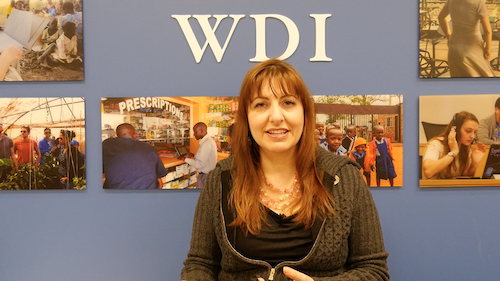
It’s a new era when it comes to cooperation between some of the world’s largest corporations, governments and nonprofit organizations working together to address some of the most pressing social and environmental challenges.
So argued Tami Kesselman, an expert in impact investing and WDI’s Global Impact Speaker in January. Kesselman followed her University of Michigan campus discussion with a video interview at WDI’s offices.
Kesselman, the founder of Aligned Investing Global, works at the intersection of corporate, government, entrepreneurial and investor communities. Among the topics Kesselman addressed in the video include:
Kesselman’s WDI talk to U-M students gave them a behind-the-scenes look at how the business, government, philanthropic and investing communities overcame years of mistrust and misaligned priorities to begin a shift toward collaborative investments. She also discussed whether this large-scale, multi-sector collaboration in every part of the world is here to stay. And she also shared why she thinks businesses should consider the Sustainable Development Goals as a whole, rather than focus on individual ones.
Kesselman earned her bachelor’s degree in Industrial Relations at the University of Michigan with a triple minor in business, economics, and communications. She then went on to earn her Master of Public Administration degree at Harvard Kennedy School, with a dual concentration in business and government.
This month’s WDI Global Impact speaker will provide a behind-the-scenes look at how the business, government, philanthropic and investing communities overcame years of mistrust and misaligned priorities to begin a shift toward collaborative investments.

Tami Kesselman, an expert in impact investing who works at the intersection of corporate, government, entrepreneurial and investor communities globally, will present the talk, “Unlikely Allies: The Evolution of Multi-Sector Collaborations and the Sustainability Movement.” It will begin at 5 p.m. Jan. 29 in room R1220 at the Ross School of Business. The talk is co-sponsored by WDI and the Erb Institute for Global Sustainable Enterprise. It is free and open to the public.
Kesselman, the founder of Aligned Investing Global, will discuss the current era of multi-sector solutions and whether it is here to stay. She also will talk about the power players behind this seismic shift from silos and mistrust to large-scale, multi-sector collaborative efforts in every region of the world. Kesselman will recount the development of the Millennium Development Goals, how they influenced the Sustainable Development Goals (SDGs) – a universal call to action by the United Nations to end poverty, protect the planet and ensure that all people enjoy peace and prosperity – and how businesses should respond.
“Kesselman is a thought leader in identifying levers and barriers to aligning capital with the SDGs,” said WDI’s Heather Esper, senior program manager of the Institute’s Performance Measurement and Improvement group. “During her talk she will share how the Millennium Development goals were originally developed, evolved and informed the Sustainable Development Goals – including the role for business in the SDGs. She will also share why businesses should consider the SDGs as a whole, rather than focus on individual SDGs.”
Kesselman earned her bachelor’s degree in Industrial Relations at the University of Michigan with a triple minor in business, economics, and communications. She then went on to earn her Master of Public Administration degree at Harvard Kennedy School, with a dual concentration in business and government.
While on campus, Kesselman also will lead a workshop from 10 a.m. till noon on Jan. 30 titled, “Scaling: From Big Avoidable Disaster to Beginning Everything with Systems Thinking.” It will be held in Room 0320 at the Ross School of Business. The workshop, sponsored by the Erb Institute, is one of Kesselman’s most popular and is based on the proprietary heuristic diligence framework she developed, SMARTimpact, that takes participants through an entire semester course on diligencing impact in under three hours. Register for the event here.
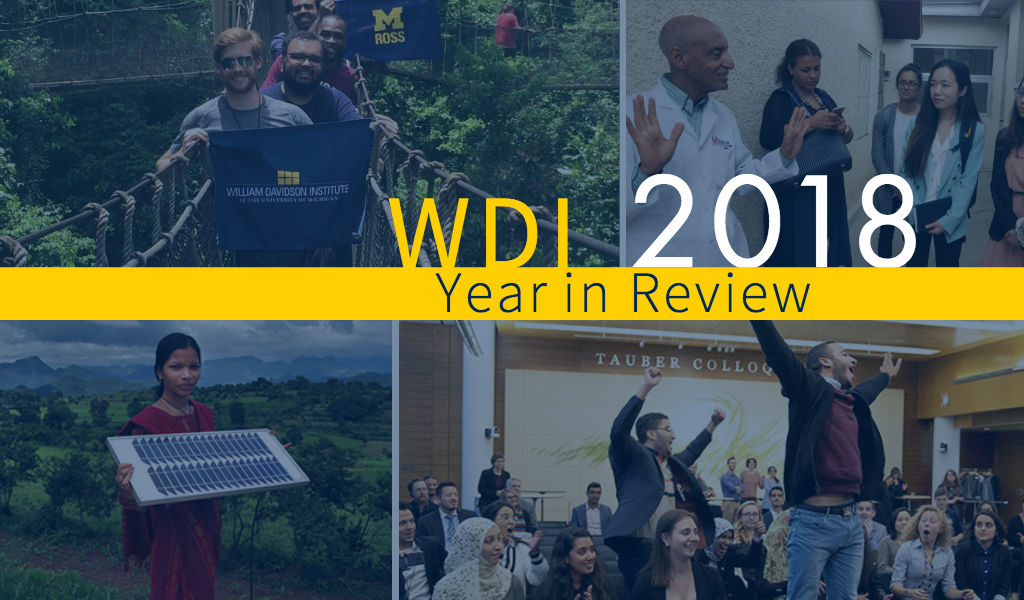
Improving reproductive health supply chains to boost access to family planning products in Mozambique. Educating senior managers from around the Baltics. Helping both investors and enterprises they support better measure impact in Latin America. Creating new MBA-level curriculum for universities in Papua New Guinea.
These partner projects are just a few examples of the work WDI performed around the world in 2018. Working with a robust set of private sector and nonprofit partners on a diverse number of projects, WDI effectively applied business skills in low- and middle-income countries (LMICs) in impactful ways.
In all, WDI teams worked on more than 40 projects with more than 40 partners in more than 40 countries this past year that focused on our core consulting sectors—education, energy, finance and healthcare, as well as our management education programs, entrepreneurship development, measurement and evaluation services and the deployment of University of Michigan graduate students around the world.
“In 2018, I was impressed by the degree to which the Institute integrated the energy and talents of our staff, University of Michigan students and faculty leaders to address multiple challenges facing for-profit and non-profit organizations,” said WDI President Paul Clyde. “While most of these projects were in one of our key focus areas—Energy, Healthcare, Management education or Finance—many drew on expertise that cut across sectors or disciplines to deliver more complete solutions.”
WDI’s project work leveraged the knowledge and expertise of the Institute’s staff, its research fellows and faculty from the University of Michigan and other world-class higher education institutions to develop business solutions in LMICs. Additionally, WDI disseminated what it learned doing work in the field through published research reports, academic journal articles and notable blog posts. The Institute also contributed to U-M student and faculty enrichment by hosting several compelling speakers at the Ann Arbor campus.

Members of the LIFE project consortium visit a produce stand in Turkey and interviews the owner on how a green grocer sources his produce and his perspective on how he could potentially benefit from the LIFE Food Enterprise Center.
Our work in 2018 spanned the globe and included projects on a wide variety of topics and issues. Among the work, WDI launched a new consulting focus area in the energy sector, connected hundreds of students using virtual technology, developed a model to train nurses for a planned hospital in Ethiopia and trained refugees in the food industry in Turkey. Here are a few highlights from our project work this past year.
Throughout the past year, WDI has widely shared its research and field work a to a broader audience through a number of publications and online journals.
“Participating in the project to test the framework provided us a holistic understanding of poverty. WDI gave us the tools to guide decision-making and track progress towards broader development goals through data collection and analysis.”
—Mónica Varela, director of impact for the Clinton Giustra Enterprise Partnership
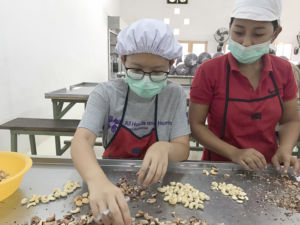
WDI intern Nadia Putri (pictured left)
A number of WDI employees penned blogs on their work or trends impacting their research that appeared on the Institute’s website.
In 2018, WDI hosted speakers as part of the the Institute’s Global Impact Speaker Series. While on campus, many of the speakers sat down for one-on-one interviews.
WDI’s Performance Measurement Initiative (PMI), along with two partners, have compiled a detailed guide for companies and other private sector partners working with USAID to help them meet project goals and generate value.
The report, “Nine Questions Every Company Should Ask to Strengthen their Partnership with USAID,” focuses on how companies can ensure good program management that’s also responsive to data. That begins with the integration of the program design (D) with monitoring, evaluation, research and learning (MERL) activities. Combined, these actions are referred to as D-MERL.
WDI’s past work with the U.S. Agency for International Development, or USAID, has shown that private companies want to use MERL to support better program management. Integrating MERL practices during the design phase improves the effectiveness of those partnerships. USAID and companies operate very differently; being able to understand those dynamics is vital for a successful partnership.
“This fall, USAID released its updated private sector engagement policy,” said Yaquta Fatehi, PMI program manager. “We wanted to create this resource because it contributes to a larger discussion that USAID is having about the role that companies play in addressing different development challenges.”
The inspiration for the paper came from a 15-month technical assistance pilot with the Women + Water Global Development Alliance. During this pilot, the BalanceD-MERL consortium – made up of World Vision, Innovations for Poverty Action, Institute for Development Impact, Search for Common Ground and WDI – served as D-MERL technical experts to support a private sector partner throughout its first engagement with USAID. In addition to WDI, World Vision and Institute for Development Impact contributed to the paper.
In compiling the paper, WDI and its partners also reviewed relevant literature and interviewed USAID Private Sector Engagement (PSE) experts and the private sector partner from the pilot. And although the paper focuses on the private sector, it also is applicable to non-profit or public-sector partners currently working with USAID as well.
The paper is designed to help private sector managers as they first embark on a partnership with USAID. For instance, the first three questions address the development of the partnership before funding is disbursed. The questions include, for example, “Who will serve as the main points of contact for the program?” and, “What information can be included in the written agreement to set the partnership up for success?”
The next set of questions is under the heading, “Setting the Foundation for Strong Program Management.” They include: “Have all partners co-developed the program’s theory of change?” and, “Have key performance indicators (KPIs) been identified to measure program outcomes?”
The final section is titled, “Integrating Data into Program Implementation,” and include questions such as, “How will the company operationalize their MERL plans?” and “What are partners’ reporting requirements? What type of reporting will be the most timely, relevant, and useful?”
Where applicable, each question may also include helpful resources and action-oriented steps to assist companies.
“Although USAID has worked on nearly 2,000 projects with companies like Gap, Inc. and Coca-Cola, there is definitely still a lot to be learned, especially for those businesses who have never partnered with USAID but would like to in the future,” said Rebecca Baylor, PMI research associate. “These nine questions are intended to help businesses and USAID achieve a measurable strategy that they can track their successes against.”
Download PDF of the report